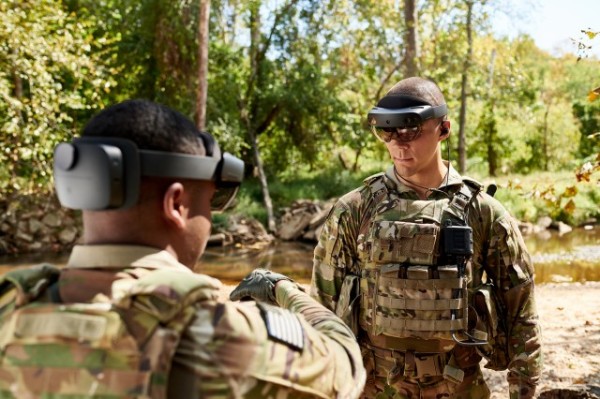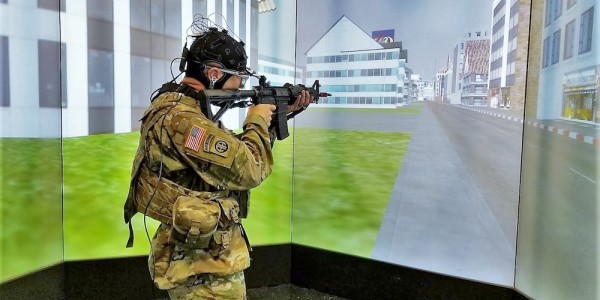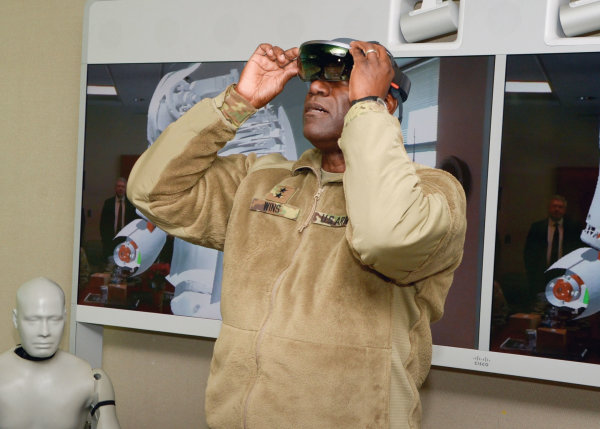The reality of real cyborg soldiers on the battlefield is closer than you think.
A new Pentagon report, “Cyborg Soldier 2050: Human/Machine Fusion and the Implications for the Future of the DoD,” goes into detail about four cyborg technologies that are “technically feasible by 2050 or earlier” — including eye enhancements for situational awareness, programmed muscle control, auditory enhancement, and “direct neural enhancement of the human brain for two-way data transfer.”
You read that right — the DoD wants to connect your brain to machines.
Carried out from September 2018 to August 2019, the study was conducted by a DoD Biotechnologies for Health and Human Performance Council group and released on Monday by the Army Combat Capabilities Development Command Chemical Biological Center.
The first feasible capability that the study outlines is a cyborg eye, with two technical ways forward. One path would include an “ocular enhancement system” being placed over the existing eyeball, in which a soldier could learn how to interpret the data being collected.
In the other, the eyeball would be physically taken out, and replaced with an enhanced eyeball. The data collected by the new system would “pass directly into the optical nerve bundle behind the eye.”
The study expects something like this to be doable by 2050. It would probably go to service members who have already lost some or all of their vision; it’s not likely that someone with perfect eyes would have tissue removed to get cyborg vision.
“In essence, the eye would be completely artificial and capable of pulling in any manner of sensory data and feeding it directly into the brain for interpretation.”
The next cyborg capability would include inserting sensors beneath the skin that would help control the body’s movement by stimulating muscles when they’re needed. The study says that something like this would help “decrease injury and mortality rates for soldiers through automated hazard avoidance.”
This would most likely be used for soldiers who have lost function of a limb, the study explains. For example, the “sensor web” would allow someone who has lost the use of their leg due to nerve or muscle damage to continue treatment, while also restoring function of the limb. The study also says that this might even provide “a long-term replacement treatment” for someone who suffered permanent damage.
On top of improving function, the study says this would eventually allow “warfighters to perform increasingly challenging tasks that often push them to the limits of their physical capability.”
The idea of combat exoskeletons aren’t new, but the study says that’s not the move — they “reduce energy” and “often impede operator performance.” But an internal system to control the body’s functions would help connect the body with an exosystem, leading to “physical behaviors that are more stable and agile.”
Auditory enhancement for soldiers aims to not only protect their hearing, but improve it. The study says because of how invasive current technology would be — physically replacing the middle-ear bones and cochlea — it would only go to service members with significant hearing loss. The enhancement would be irreversible.
But, by 2050, new technologies may be much less invasive and more accessible. Capabilities developed down the line could even include real-time language translation.
And now the big one — connecting soldiers’ brains to machines.
The fourth capability the study says could be ready by 2050 includes neural implants that would bring “seamless interaction” between the soldier and drones, weapon systems, or other “remote systems.” It wouldn’t just allow for transmission of human data to machines, but the other way around — machine to brain — as well as human to human interaction.
It would totally eliminate the need for things like joysticks or keyboards to control technology.
Brain activity would be measured through electrodes on the outside of the skull, or through electrodes directly implanted in the brain.
“The potential for direct data exchange between human neural networks and microelectronic systems could revolutionize tectical warfighter communications, speed the transfer of knowledge throughout the chain of command, and ultimately dispel the ‘fog’ of war,” the study says.
According to the report, neural implants are anticipated to start being used by Special Forces, military pilots, drone operators, and intelligence personnel by 2030. By 2050, that circle would expand as the technology is better understood and it becomes more widely available.
As wild as it all sounds, there are of course dozens of questions that still need answering. For example, how does the DoD manage the societal, ethical and legal implications of cyborg soldiers? It’s no secret that there are a number of concerns that come along with the military’s use of things like augmented reality — the physical integration of these advanced capabilities will be no different.
There are also questions of what would happen to soldiers with these enhancements after they leave the service. The study even gave it a name: Post-enhancement Distress Syndrome (PEDS), which researchers expect would give soldiers “feelings of inferiority or withdrawal, or even a form of depression…with the non-enhanced state.”
The report also recognizes how individuals with mega-enhanced hearing, eyesight, or cognitive abilities might would have a “defined competitive advantage” over average people in society. How would that be managed?
And what would long-term care for these kinds of implants look like? How would maintenance be sustained by the Department of Veterans Affairs?
Overall, the study says that scientists and engineers working on things like this “move cautiously,” and work to understand the unintended consequences, but that the benefits of “human/machine fusions will be significant and will have positive impacts on the human quality of life.”

























